I was not sure if I would have the chance to fish in Mexico, but in case I did, I brought along a minimal “assortment of lures I thought were “best guesses” and universal in nature. I brought along:
1) Some of my salmon jigs, in various shades of pink, fuchsia (red) and purple
2) Some of my inline spinners
3) A variety of spoons including three Dick Nites
4) A few buzz bombs
5) Three Rapala plugs
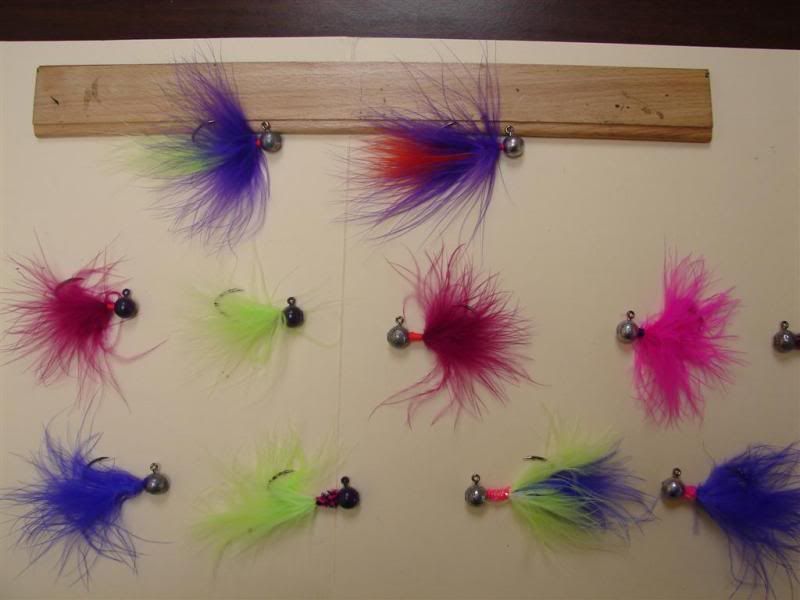
I brought jigs that looked like these above
All of these items fit into a standard 3700 Plano box along with a 0.75 lb coil of pencil lead, octopus hooks, and other minor tackle. In addition I brought a small selection of soft plastic baits.
Much to the relief of the bass residing in Lake El Salto, I was going to be fishing in the saltwater.
The last time I was here, I came close to catching fish but skunked out on both outings. I was determined not to let that happen again.
On the day I arrived, the whole family walked along the main strip that hugs the coast. Not only was I enjoying watching the scenery, I was making mental notes of the spots I was going to fish. I observed two persons fishing with rods in one spot that I had tried on my last trip. I told my wife that I was going to try the spot the guys were fishing and she told me that one time a tourist was taking photos there and a wave knocked him into the water and the person died.
I took that in stride and promised myself that I would be careful.
Fishing on Day One - Thursday, 11-24-11
I woke up early, about 6:00 in the morning and headed to the water. I learned since my last time here (skunked out, went 0 for 2) I learned that bait is the ticket here. I challenged myself to see if I could catch a few fish on artificial lures.
The first thing I did when I arrived at my spot was to check the size of the waves. They were on average about 4-5’ high with an occasional slew of slightly higher waves periodically passing by. Whew! In addition, it appeared to be high tide and deep enough that I couldn’t see the bottom.
I started off with a River Fisher spoon. During the spoon’s descent, a wave came along and slammed it into the rocks. It was stuck… Really stuck. I broke the line and tied on another one. Eventually, I lost that one too.
Next, I tied on a Carolina rigged Dick Nite spoon and thought to myself, this is going to be money. After a good number of casts, perhaps a span of thirty minutes, I lost two of my three Dick Nite spoons. This was disappointing because my gut was telling me that if I had more time and more DN spoons, I should be able to crack the puzzle and catch fish.
I changed tactics and started twitching jigs. Pink jigs kicked off this assault, after which purple and chartreuse jigs followed. Unfortunately, the fish were not interested in any cadence or manner of twitching I tried. Neither erratic nor smooth jigging and neither furiously burning the jig nor leaving the jig to the mercy of the powerful waves could bring them out. In the end, the waves and rocks once again claimed a good number of jigs.
It was not yet frustrating, but I was getting a bit concerned since I was burning through my list of lures with no results and losing line with every snagged lure.
Buzz bombs were now up to bat. I wound up losing three of them.
I tried the drop shot with soft plastics and it was costly. All I wound up doing was losing a lot of line and pencil lead.
By this time, my reel was at about 45% of capacity and enough water had retreated to reveal that the areas I was casting my lures were laden with large rocks. It was no wonder now why I was losing lures. I placed my next casts into “pockets” and “openings” amid the rocks much like a bass angler would pitch to a hole in the lily pads.
I tried inline spinners next. They also produced a result of nothing.
I finally tied on a red jig and halfway through the retrieve, a school of fish that were white and quite flat-sided, came out of nowhere and zipped toward my jig at lightning speed.
“This is it!!! Finally!” I thought to myself. It was not to be.
They initially swarmed around it and then made what I will call “false” strikes. They would dart madly toward the jig and then dash away. The school swam away as fast as they appeared.
Was I close to cracking the puzzle? Nope. I was unable to duplicate the response. They did not come back.
I employed crankbaits next but they too could not solicit strikes or interest.
The last lure of the outing was a one-quarter ounce Blue Fox spoon. Fortunately, another group of fish swarmed around it and then attacked. I don’t know how, but they pecked the living dickens out of the spoon without evening touching the hook! Like the first school I saw, they sped off almost as quickly as they appeared.
I had to call it a day because my fishing liberty expired and my reel only about 20% full. Surprisingly, I was not bummed. Round one definitely went to the fish. Round two was going to be different. I was going to use shrimp.
Day Two – Tuesday, 11-29-11
This time, I came to the party armed with shrimp. I was also hoping to make good on an offer I made to a neighbor, who loved to fish. The last time I was here, he and I went fishing. Unfortunately, the condition of his knee made walking difficult let alone fishing. After talking to him the evening before, I told him that I would give him whatever I caught.
I accompanied my mother-in-law, who walks daily in the early morning in the area that people like to fish. As we walked, she told me of a spot where she saw people catching fish the other day. Three older gentlemen were fishing at that spot so I chose a location nearby.
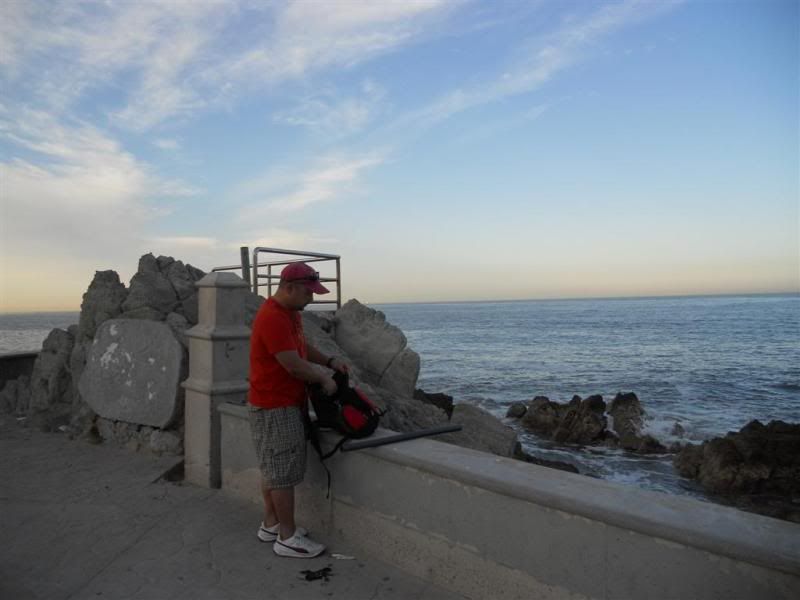
Getting ready for battle. I was not going to be denied today.
As far as I could tell and in terms we are familiar with in the Pacific Northwest, they were plunking, but hand and line style, i.e., without a rod. This is an awesome and very fun way to fish. However, I am not experienced enough to make accurate casts with it so I stuck with using a rod and reel.
The first tactic to use that came to mind was to tip a jig with shrimp as one might do when targeting chum salmon. Because I didn’t have too many jigs left, I put that idea on the back burner and decided to employ a tried and true method that local anglers use and one I am accustomed to using. In essence, the rig they use is a drop shot. For those that do not know, the drop shot in rudimentary form is a rig where one places the weight at the end of the line with the hook placed a certain distance above it.
The waves were larger than the first time I fished, approximately 7-9’ high on average with a few waves even taller! They looked menacing. A few of them made me nervous even though I was a “safe” distance above them. The waves roared as they crashed on the rocks.
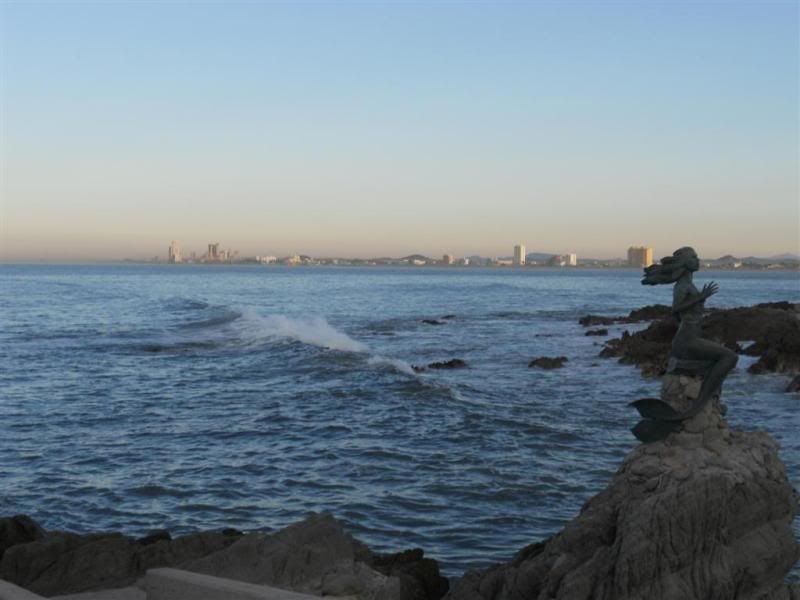
This wave was part of a small set that rolled in. Water from bigger waves that crashed onto the rocks occasionally reached the tail of the mermaid. This is the spot they say the tourist got killed.
I pitched my drop shot rig and as soon as it hit bottom, it got stuck. Before frustration could get the best of me from which a childlike tantrum would follow, (I thought I had lost enough gear and line on the last outing and the routine of snag, break-off, lose lure and line was becoming unbearable), a huge wave rolled in and freed it with the greatest of ease.
A light bulb lit up in my mind (a rare occurrence I assure you) and I immediately made some changes to my approach. I used heavy weight the first time without giving it any more thought. Then, seeing the others plunking reaffirmed this for me to use heavy weight again. I reeled up the line and used a lighter weight so that the motion of the waves and water could make the bait “go along with its flow,” similar to drifting a corkie in a river. The key difference between this method as opposed to fishing in a river is that the rig could move in more than one direction. The weight and bait would drift completely at the mercy of the water’s movement.
I also knew now that if my rig got stuck, I ought to let a wave try to free it before I decide to break the line. This revelation proved to be a gear saver. By the end of this outing I didn’t lose more than 25% of my line.
After making the first cast using less weight, the waves did their thing. It was cool watching the line drift about 15’ one way and then nearly the same distance in the other direction. Barely a minute had passed when I started feeling a series of pecks and strikes and eventually pulled this guy up.
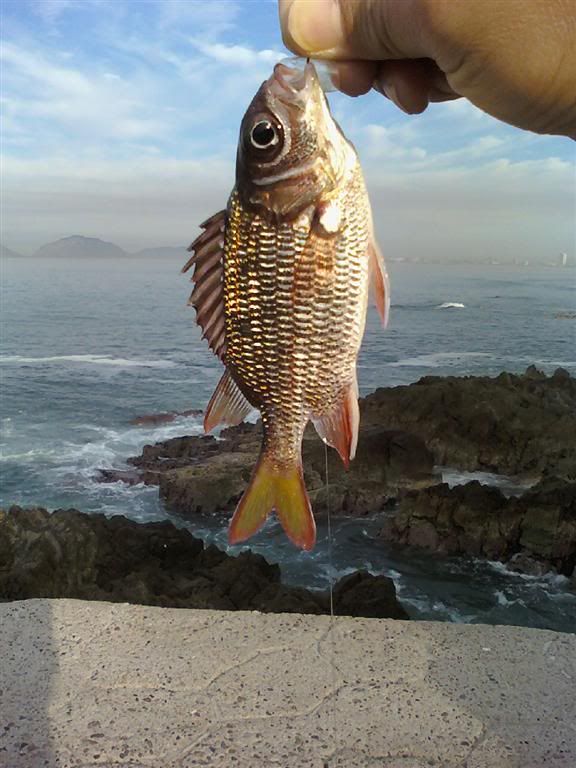
I learned later that these cute little buggers are called Chiopas (Chee-oh-pahs) and that the locals don’t eat them.
A few minutes later, I caught what looked like some kind of rock fish.


This is what they call a Cabrilla (Cah-brree-yah – don’t forget to roll the “r”, lol).
Alright! I caught another one, the third species of the day. I learned later that it is called a Perico, a parrotfish in English.
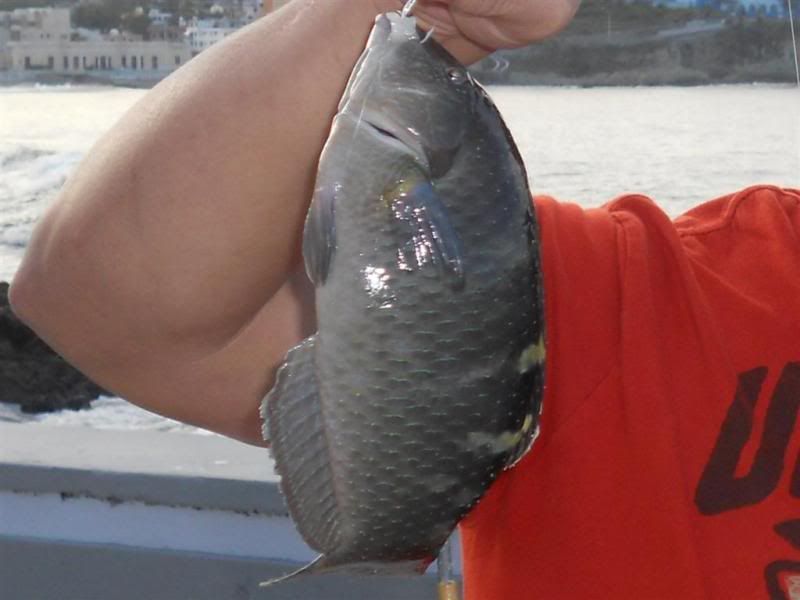
A Parrotfish
Over the course of the morning, I would go on to catch four different species of fish.
3 Chiopas (Could not find any information this other than it not being good table fare)
5 Cabrillas (in the scorpion fish family)
1 Perico (Parrotfish)
1 Mojarra (a type of surf perch)
I made good on an offer I made to a neighbor and gave him what I caught. He was very happy and grateful to receive the fish and the joy on his face made my day. This was definitely a sweet day.
It was through him and my father-in-law that I learned what they call the fish. Unfortunately for the neighbor:
1) I released all of the “ugly” Cabrillas because I thought they wouldn’t be good to eat.
2) I kept the Chiopas because I thought they might be good fried.
I was wrong. It turns out that the ugly Cabrillas are very good table fare, usually prepared in a soup and that practically nobody eats the Chiopas. In the neighbor’s words, “Chiopas is only good for the cats.” The Parrotfish and the Mojarra were both considered good eats. Well, at least I brought a few fish worth eating.
Day 3 Thursday, 12-01-11
I decided to go the artificial route again for the challenge and returned empty handed. The only plus was I stopped after only a couple hours of fishing as opposed to five hours as I did in the first outing.
Day 4 Friday, 12-02-11
I got up early and headed to the market to buy some shrimp at 6:00am. I bought 20 pesos worth of raw shrimp. These shrimp really looked good for eating so asked for a second bag and divided my purchase in half just in case the fishing wasn’t good. I could at least have a decent meal with some shrimp.
Got to the spot at 7:00am and found a two people fishing with rods and reels. A third person also with a rod and reel, joined them on the rocks I fished the first day. There wasn’t any room for me so I moved to another spot.
I sparked a conversation with a fourth angler (a hand and line angler) as I was setting up my gear and he went on to say that the way my rig was prepared that I was going to have difficulty catching fish because the hook had no give.
Let me tell you where he was coming from or what he meant. The way that they set up their “drop shot,” rig differs from the “bass” way in this way – For the latter, the “bass” drop shot rig, the hook is tied directly to the line, usually with a Palomar knot. For the former, they use a kind of knot that appears similar to the dropper loop but when knot is tied, the hook is tied to the line in a ways that it is free to move not only with the current, but also with the fish’s strike. To get a visual, picture your main line coming straight down and then out 90 degrees for 4-6” where the hook is fastened. Then the line goes back toward the main line and proceeds downward from there so that you can attach your weight. All of this is done with the main line and without the use of a swivel or any other tackle.
He went on to say that the hook rigged this way takes the swiping attack the fish make into account and enables to bait to flow with the water’s movement. There might indeed be some plausibility to this because at times on day two and today, I felt like I was giving the fish a free breakfast. My hook came back bare many times.
He also went on the say that I wasn’t using enough weight and that I needed to use a lot of weight to keep it down. At that point, I shared with him that I caught some fish the other day fishing the opposite way. I gather that he dismissed what I said. He scrounged around through his tackle bag until he pulled out a spark plug. He said in Spanish, “Use this as a weight. I like to use these as weight because they’re heavy. You can have it.”
He proceeded to tie the plug onto my line. I thought to myself, “Oh well - when in Rome…”
Next, he went on to join the three other guys. I continued to work my spot and fished within sight of them.
After a few casts, the spark plug fell off and nearly cost me a nasty bird’s nest. Whew! I tied on a about ¼ oz piece of pencil lead and fished my way. In a short amount of time, I landed my first Pargo. It was a baby, but it was in the blue gill pan-fried class so I kept it. I was fishing for my in-laws this time. I landed another Cabrilla next.
When I hooked my third fish, my line got caught on the rocks as I was reeling in the fish. To make things more difficult, the fish was also in the rocks. I was in a pickle now. My options as this point were:
1) Leave the fish to die and break off the line.
2) Go for the fish, but risk getting bashed by a big wave or slip off the rocks and into the water and/or risk getting my gear stolen as I climbed down the rocks.
Did I mention the waves were huge? Some of the waves even reached where I was fishing. Anyway, I felt I owed the fish the dignity of not letting it die there since I was the one who put it there. I proceeded with extreme caution, triple checking my footing and hands with every move I made. If you have to know, the rocks were very slippery and sharp!. As I made my way down, I followed my line to the fish like Hansel and Gretel followed pebbles to find their way home. As I descended toward the fish, I watched the cycle of waves. I observed from previous outings that the waves came in sets of similar size. It was a period a larger waves so I felt I should wait until they passed. It made me anxious being caught on a rock and a hard place, between my gear and the fish, waiting for a set of smaller waves to come. I was also a sitting duck for having my backpack stolen.
A set of smaller waves finally came and I moved carefully toward the fish. It was a nice fish. I didn’t know what it was for sure, but it looked like a Mojarra. The cycle of larger waves was approaching and I made my way back as fast as I safely could. By the time I got to my last push up the rocks, one big splash caught my back. Whew! I am not going to tell my wife about this. I am also glad I was not wearing flip-flops!
The same guy who gave me the spark plug dropped by to see how I was doing and asked, “Did you catch anything?”
I answered, “Yes, just a few small ones.”
The look on his face suggested to me that he was pleasantly surprised. I asked if he caught anything and he said that neither he nor the others caught any fish.
He confirmed for me that the third fish I caught was indeed a Mojarra.
All of the other anglers were using artificial lures, including the guy that gave me the spark plug. When he saw my fish, he saw the bag of shrimp and made a beeline toward it. He took a piece of shrimp, put it on his hook and pointed to the opposite side I was fishing and said, “This is a good spot,” as he threw his line one.
I told him, “Please, feel free to use my bait.” I wasn’t sure if such sarcasm would be humorous in Spanish, but he chuckled and apologized for not asking first. His is excuse was he was simply desperate to get into some fish.
We were getting hits with every piece of shrimp we dropped into the water, but the fish were crafty enough to take the shrimp without taking the bait.
On one cast, I felt a nice slam. My first thought was that I finally had a big fish on. My rod bent down fast and stayed that way. This fish dragged my line over the exposed rocks and that worried me a bit but not enough to lose focus. We fought for a while and with how hard and forceful it was pulling, I was thinking it was probably a 10lb. fish.
The guy I was fishing with helped me by pulling up my line and when saw it, he said excitedly, “¡Es un Toro!”
I reeled up the line as fast as I could and I couldn’t believe it. In my mind, I had pictured a 10lb. beast but it actuality it was this little Toro, or Torito. These were the fish that swarmed around my lures on day one, but I didn’t know what they were called then.
I was very impressed with this Torito. It fought with the gusto and spunk of a smallmouth bass.
Despite the tons of hits we both continued to get, we could not land any more fish in this spot. It became another free breakfast session for the fish. The guy left to try somewhere else and I decided to go back to the spot I skunked out on days one and three. I was not going to leave it until I caught at least one fish or ran out of shrimp.
As luck would have it, I caught another Cabrilla. I was glad to get that no-fish catching monkey off of my back in that spot. I packed my stuff up and called it a day.
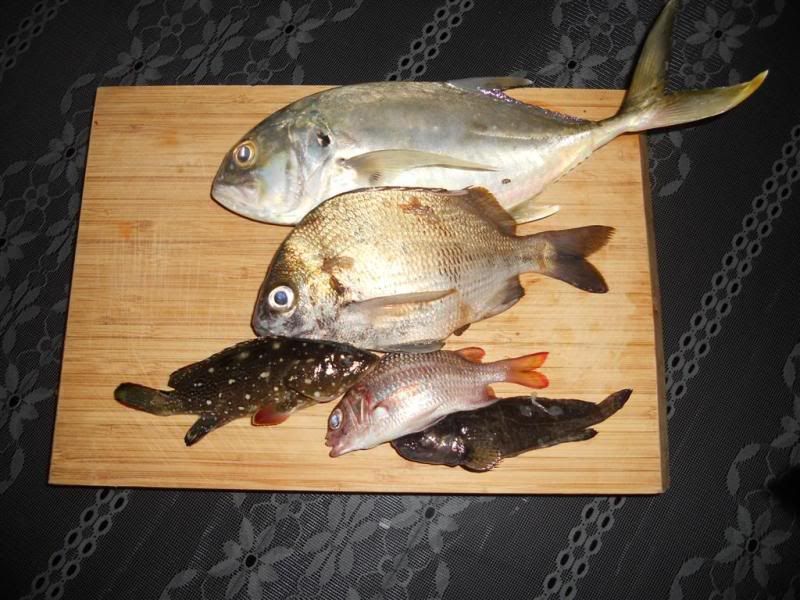
From Top to Bottom
A Toro – That translates to Bull in English – I think it might be a Jack Crevalle
A Mojarra - A type of surf perch
A Cabrilla - Starry Grouper (according to an online source)
A Pargo Amarillo - Yellow Snapper
A Cabrilla –
My mother-in-law prepared the Pargo, Toro and Mojarra by scoring them on the sides, seasoning them and sealing the deal by frying them. The Cabrillas were left for another time. I am told they’re good in soups.
She ate the Mojarra and Pargo. Others ate the Toro. They were all very delicious.
So ends my fishing adventures in Mexico. It was a mix of anticipation, trial, error, perseverance, patience, risk, reward, reflection, joy and deep gratitude to the Man upstairs for blessing me with this opportunity. I hope that I will be blessed once again with another chance to battle these fish again, and may their larger brethren find a way to the end of my line.
Fishing Conditions and Gear Used
Weather
Warm, Probably 80 degrees F everyday, Windy Gusts on occasion
Gear
6’6” Shimano Clarus Medium Powered Fast Action Rod
Shimano Curado 201 DHSV Reel
10# Sufix Siege Monofilament – The line was absolutely incredible. Decent abrasion resistance considering the environment I was fishing in and learning many anglers use 80# test!
Merry Christmas to everyone! It isn’t much, but it’s my gift to all of you.
-A.L.A. aka ib

